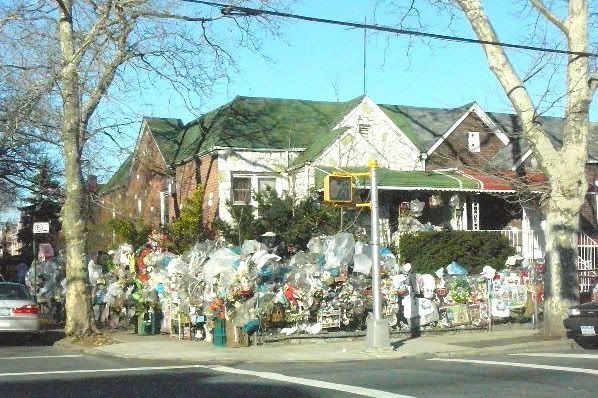
I wandered upon this house in East Flatbush a few months ago and had to capture an image of it. I knew there was a story that went with it. The city lore blog: sense and the city recently found out.
A few blocks past the tabernacle churches, hair-braiding salons, and Laundromats of Church Avenue lies a quiet residential neighborhood. Dogs bark. Children play catch in driveways. Ornamental cabbages grow along the edges of the sidewalks. But at 615 Lenox Road, at the corner of East 43rd Street, the suburban Brooklyn birdsong seems to swell. This is the home of Manny, a Vietnam vet who for the last twenty years has been transforming the chain-link fence around his house into a paradise for local birds.
“Some people like cats, some people like dogs; I like birds,” Manny told me. He said he got the idea for the bird fence when he saw a similar installation in Texas, where he was in the air force. Manny is from Panama, middle-aged, with dark skin and milky blue eyes that give him the appearance of being blind, though his vision—in the many senses of the word—is obviously keen. On the afternoon I visited, he was making the rounds of his fence in camouflage pants, vivid blue and green Nikes, and a hat with earflaps held together by a safety pin. His house is modest, covered in faux-stone siding, a corrugated metal roof over the porch. But even from a few blocks away it’s the fence you notice first, and the bush in the front yard that quivers with the hundreds of birds that call 615 Lenox Road their home.
“In the mornings the sidewalk is filled with birds,” Manny says, gesturing down the street with the tip of his cane. He suffered injuries in the war and walks with a limp, and he claims his hands don’t work as well as they used to. Still, every morning he sifts birdseed into the hundreds of cages and birdhouses that festoon his fence, and the birds arrive in droves; some even spend the night. “But the neighbors don’t mind, because I keep things clean,” he says. Manny’s English is impeccable, though his accent is barbed by the five languages he picked up during the war.
Manny’s collection includes wooden birdhouses with heart-shaped holes and slanted roofs, bird churches with steeples nestled in beribboned Easter baskets, traditional wire cages with swinging perches and feeding dishes, bookshelves lined with miniature houses and bird figurines. The blank spaces along the fence—and there aren’t many—are filled in with bird-themed doormats and chair pads and other souvenirs, all draped with bright flower garlands.
As the birdhouse fence grew into a neighborhood fixture, he says, people began to leave contributions on his doorstep. During the winter, when there are fewer birds, he covers the houses with an equally motley collection of plastic bags—Sears, Duane Reade, Met Foods—to protect them from the weather. But in the spring he unveils them, and birdsong and the colors of his collection fill the Flatbush air once again.






No comments:
Post a Comment